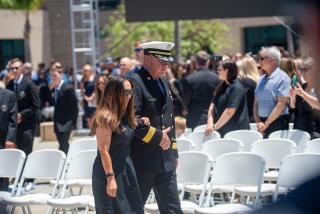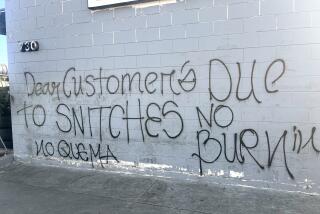Accident Raises Service Advisor, Tire Defect Issues
- Share via
Joven Mapa, his family packed in its 1991 Ford Aerostar, was headed to Las Vegas 2 1/2 years ago when the left-rear tire blew out and threw the minivan into a rollover. Today, Mapa is a quadriplegic.
Tire blowouts are relatively rare. But what was even more unusual in Mapa’s case were the allegations he brought in a lawsuit against El Monte Ford and Dunlop Tire Corp.
A Los Angeles Superior Court jury returned a $15-million verdict last week, based on Mapa’s allegations that the dealership service advisor had failed to disclose that a mechanic had found the left-rear tire to be defective. Mapa also contended that the Dunlop Axiom tire had manufacturing and design defects.
Mapa had taken his vehicle in for service just before leaving on the trip, according to trial testimony. Among the services he requested was a tire rotation. On the internal work order, the mechanic had noted that one of the tires on the Aerostar had a serious defect known as a separation.
Mapa was never told about the separation, according to his attorney, Don Fountain of West Palm Beach, Fla., who specializes in tire-blowout cases. That scenario doesn’t square with El Monte Ford’s policies, although the company could not prove what happened that day.
The same day Mapa picked up the van from the dealership, he called back to say that the steering wheel was pulling to one side. He returned to the dealership and the tires were rotated back to their original positions. Again, no mention was made of the defect, according to his testimony. He then made a third trip to the dealership, this time to have new heater hoses installed that the dealership had not had in stock during his two earlier visits.
The tire blew out and the van overturned on Interstate 15 on Nov. 15, 1997. Mapa underwent two operations to stabilize his neck, as well as have part of his stomach and intestines removed. He was hospitalized for 200 days and now requires 24-hour care. Lesser injuries were sustained by the other occupants: Mapa’s wife (a Los Angeles Times employee), his three children and his wife’s parents.
Auto service is seldom considered a matter of life and death, although clearly it can be. What went wrong in Mapa’s case?
It isn’t clear why Mapa left the dealership driving on a defective tire, but it may have been a case of things simply falling through the cracks, Fountain said.
Peter Callahan, El Monte Ford’s attorney, said he believes that Mapa was told about the defective tire but that he elected to shop elsewhere for a cheaper replacement. But there was no proof of that theory.
“We don’t remember this guy,” Callahan said. “So we can’t say what we told him.”
Nearly all dealerships use service advisors, also known as service writers. They sit behind a desk, work on commission--and normally have clean fingernails.
Their job is not to repair cars but to sell services and products. How the El Monte service advisor allowed Mapa to leave without buying new tires is a big irony.
“There is a tremendous financial incentive to sell tires,” Callahan said. “This is an odd one. Usually it is just the opposite: We are accused of selling things people don’t need.”
*
There was more to Mapa’s case than his service advisor, however.
Dunlop had designed the tire without using a nylon cap ply, a shrinkable cap often used between the steel belts and the tread. Dunlop experts said the cap was unnecessary based on the tire’s speed and temperature rating.
Mapa’s suit claimed that its absence was a defect and that the cap would have prevented the blowout. Attorney Fountain said the tire separation occurred when the rubber between the belts and the tread did not bond properly during manufacturing.
Dunlop attorney Todd Theodora said the jury verdict was flawed because of irregularities in the trial. He said there was ample evidence that the tire had been previously damaged when it sustained a major road-hazard blow that broke 30 of the steel cables inside the tire.
“The only way you can break 30 cables is to run over something substantial,” Theodora said.
But Fountain said that theory is widely cited by tire makers to cover up defects, something known to trial attorneys as the “phantom road-hazard defense.”
The jury assigned 12% of the liability to Mapa himself, reducing the verdict by $1.8 million. Evidence in the trial indicated that he was speeding and that he should have been able to control the vehicle. Mapa had asked for damages of $100 million. An appeal is forthcoming.
*
There seem to be two important lessons to draw from this case.
First, tire separation is an extremely serious defect. It occurs when one of the internal layers of the tire becomes separated from surrounding layers. In past columns, I have discussed the causes of separation, which include water damage, manufacturing flaws and road hazards. If you hear a tire thumping or see an unusual bulge, get it inspected immediately.
Second, consumers need to know more about service advisors. Some dealerships have mechanics working as service advisors, while at other shops almost anybody with good sales skills can become one. Obviously, it may help to know something about your service advisor.
“The key for this dealership is that they want service writers to be communicators,” said Callahan, El Monte Ford’s attorney. “Some great mechanics are not great communicators.”
Nonetheless, service advisors should know more than customers. When lives depend on it, the customer should be able to get the story straight from the mechanic.
*
Ralph Vartabedian cannot answer mail personally but responds in this column to automotive questions of general interest. Write to Your Wheels, Business Section, Los Angeles Times, 202 W. 1st St., Los Angeles, CA 90012. E-mail: ralph.vartabedian@latimes.com.







